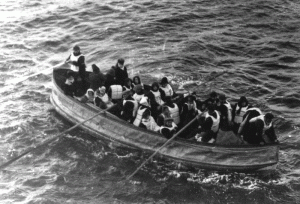Looking back on the Titanic: what have we learned?
 You might have heard that this Saturday marks the 100th anniversary of the sinking of the RMS Titanic. From the re-release of the epic movie to James Cameron’s historic dive to the Marianis trench, coverage of the anniversary has been buzzing everywhere. But what have we learned from the Titanic anyway? (Other than that epic shipwrecks make for great movies.) What’s different now that would keep it from happening again? A few things:
You might have heard that this Saturday marks the 100th anniversary of the sinking of the RMS Titanic. From the re-release of the epic movie to James Cameron’s historic dive to the Marianis trench, coverage of the anniversary has been buzzing everywhere. But what have we learned from the Titanic anyway? (Other than that epic shipwrecks make for great movies.) What’s different now that would keep it from happening again? A few things:1. Designing a ship
It might seem impossible, but there’s one thing even James Cameron’s budget can’t quite do: build an unsinkable ship. Over at Scientific American they spoke with Henry Petroski, author of To Forgive Design: Understanding Failure. All designs have flaws, he says, and here are some of the ways in which even our modern ships can go down.
The Titanic’s big problem was its 16 watertight compartments. Scientific American explains.
The 90-meter gash in the Titanic’s hull caused the ship to take on water near its bow, flooding six of the compartments. When enough water had penetrated the hull breach, the ship pitched forward at an angle that caused water from the individual compartments to spill over their bulkheads, inundating the front of the ship and sending the Titanic like a torpedo to the ocean bottom almost four kilometers below. Had the bulkheads been higher, or watertight at the top as well as the bottom, the water rushing into the hull might have been distributed more evenly, giving passengers more time to escape.
We have gotten better at designing ships though. They’ve ditched the compartment design, and cruise ships these days are double hulled. Ships are built of different, stronger materials and designed and engineered to be stronger and more maneuverable.
2. Keeping people safe
Over 1,500 people died in the Titanic accident. Today, and partially because of the gigantic ship’s fate, we’re better at saving people who do find themselves shipwrecked. While of course it could happen again (Costa Concordia anybody?) we’re much better prepared to swoop in and rescue the unlucky passengers. Here are a few things that have changed since the Titanic:
 Ice patrols: The Titanic was warned that there were icebergs in the area, and even of some specifically big ones. But the men in the birds nest didn’t see the actual hunk they hit until it was too late. Today, there are ice patrolling aircraft and radar to keep an eye on the floating giants.
Ice patrols: The Titanic was warned that there were icebergs in the area, and even of some specifically big ones. But the men in the birds nest didn’t see the actual hunk they hit until it was too late. Today, there are ice patrolling aircraft and radar to keep an eye on the floating giants.Life support: The Titanic’s unlucky passengers also had to contend with a lifeboat shortage. Today, all ships must have enough life boats and life jackets to save everyone. Crews also aren’t allowed to skip the lifeboat drill to go to church, like they did on the Titanic.
Rescue me: Once people are in the water, we can now rescue them much faster. Navigational and communication technologies are far better, and help can travel far faster in motor boats and helicopters. Of course, as the Costa Concordia disaster shows, which claimed 30 lives, fatalities can still occur.
3. Re-making movies
Okay, so this one isn’t really something we learned from the Titanic itself, but it is a lesson. How did James Cameron convert a movie from 15 years ago into 3D? There are two key parts, according to the New York Times.
No more shadows: 3D works by giving your right eye and your left eye two slightly different images. That creates a shadow between them where information is lost. Animators had to fill in those gaps with pixels from areas nearby.
Depth of field: a key part of 3D is making things look like they’re coming at you or receding into the background. Artists had to create this illusion for shots where there are characters interacting. To do so, they assigned each layer a level of depth and made a map - kind of like a topographical map of a mountain. They could then pull different layers forwards or backwards.
You can return to the main Market News page, or press the Back button on your browser.

